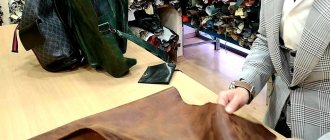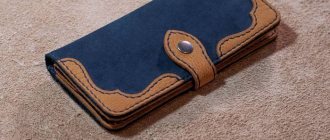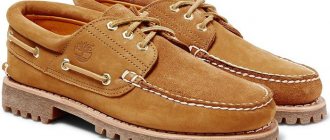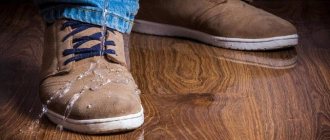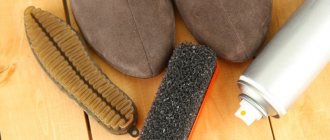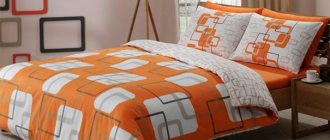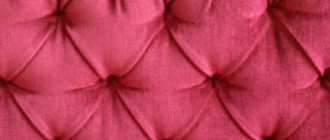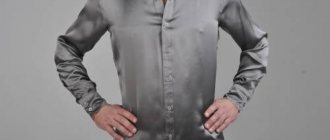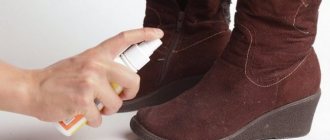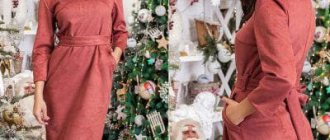Features of materials
Both materials are brushed leather. However, having similar organoleptic properties, they differ significantly from each other in performance characteristics. The differences between nubuck and suede are due to the characteristics of the base raw materials and the specific processing.
Nubuck
Nubuck is made from the skins of cattle: bulls, yaks, buffaloes. Tanning is carried out using the chrome tanning method. The final stage is grinding using fine abrasive materials. The result is a fabric with very short fibers, which is almost impossible to stretch.
Used primarily in shoe and haberdashery production. Thanks to the porous surface, air is perfectly permeable, so feet in nubuck shoes do not sweat. The disadvantages are the following properties:
- Requirement for care. Without regular treatment with special brushes, the material begins to become shiny.
- Instability to moisture. On a material not treated with water-repellent impregnations, stains form upon contact with water, the canvas itself becomes rigid and can be deformed.
Typically, manufacturers indicate on the label if the material has undergone special processing. If there is no such mark, you should apply a protective compound to the new pair yourself.
Due to its resistance to impacts and stretching, nubuck is widely used in furniture production. If it is additionally treated with a special oil composition, a completely new material is obtained - nubuck oil, which has moisture-proof properties. Tactilely and visually it resembles natural leather. The material is smooth, stretches well, and when touched there is a feeling of moisture.
Natural nubuck
Suede
Suede is one of the most expensive types of polished leather. The classic version uses reindeer skins. It is acceptable to make leather from elk, goat, and deer. The material is produced using the fat tanning method, which ensures the thinness and velvety feel of the fabric. Its pile is higher and softer. Also, unlike nubuck, suede fabric stretches easily. In addition, suede perfectly allows air to pass through, holds its shape for a long time and retains its original appearance. Excellent for allergy sufferers due to its hypoallergenic properties. When unpainted it has a light beige color. In addition to shoes, it is used for the production of small haberdashery - gloves and bags, country and boho style clothing.
The main disadvantage is the same as that of nubuck - low moisture resistance. It is recommended to use such items only in dry weather. If the product gets wet, it must be completely dry before restoration. Brushes specially designed for suede will help restore the velvety feel.
Treat with water-repellent impregnations only when absolutely necessary - there is a high risk that the material will become more rigid. Before applying, you need to test the effect of the product on an inconspicuous area.
Natural suede
This is interesting: Holofiber - what kind of material is it: filler, description of types, pros and cons
Suede and nubuck: what is it?
Suede is one of the most expensive types of polished leather. It is made from the skins of large animals. During the production process, these raw materials are processed by fat tanning; as a result, the fabric is thin and velvety, with a high and soft pile.
Leather of this type is hygienic and breathable, easily stretches, and does not lose its shape and attractive appearance for a long time. In addition, it does not cause allergic reactions.
The disadvantages of the material include low resistance to moisture - therefore it is better to wear such shoes or clothes only in dry weather. In addition, it is recommended to treat the surface with special water-repellent agents to protect the product and extend its service life.
Nubuck is also made from the skins of large horned animals. When making them, the chrome tanning method is used, and grinding is done using fine abrasive materials. Due to this processing method, the fibers are short, and the fabric does not stretch as well as suede. In addition, the surface of the material tends to quickly become greasy, especially if it is not properly cared for.
The porous surface of the nubuck fabric is breathable, allowing the skin to breathe. This material also does not like water and without the use of special impregnations it will quickly lose its presentation.
Advice
Nubuck is often passed off as suede and this economical product option is sold at a high price. To avoid becoming a victim of an “unscrupulous” seller, you should carefully study the product before purchasing. It is difficult to notice the differences only at first glance, but if you look more closely, they are not difficult to see.
Nubuck
This is one of the varieties of natural leather. Despite the fact that nubuck products are widely represented on the market, there are many false statements about it. For example, for some reason many people believe that this is one of the varieties of leatherette. In fact, this is genuine leather treated in a special way.
Important! The manufacturing technology is as follows. The leather is subjected to chrome tanning and then polished using abrasives: sand, sandpaper. The purpose of this treatment is to obtain a velvety surface that is very pleasant to the touch.
Another typical mistake: they often equate suede with nubuck. Although they have only one thing in common: they are based on the skin of various animals. To obtain nubuck, cattle leather is used, which determines its strength.
The scope of its application is quite diverse:
- Making footwear: boots, shoes, boots: for men, women and children.
- Bags, purses, accessories.
- Outerwear. Vests and jackets are quite durable and warm, although they are not as common as suede ones.
- Furniture production - as upholstery, as an alternative to leather and textiles.
Important! It is hardly correct to say that nubuck or suede is more practical, since each of them has its own area of application.
Advantages:
- Beautiful appearance.
- Vapor permeability (the material “breathes”).
- Reasonable price.
Important! To appreciate all the advantages of this material, you need to be able to determine the quality of products and care for them. As an example, here are useful tips regarding shoes, since they are the most popular in using such material:
- How to choose the right nubuck shoes?
- How to clean nubuck boots?
Flaws:
- Need for special care.
- Inability to wear in wet and dirty weather. Clothes and shoes can be hopelessly damaged.
- Less durable than regular leather.
Kinds
In addition to natural, there is artificial nubuck. Outwardly, it looks like natural material and is quite wear-resistant. However, the “breathing” effect in an artificial product is completely absent. Breathability is also lower than that of natural tanned leather. The cost of products made from artificial material is quite low.
In addition to natural and artificial nubuck, there is also a third variety - nubuck oil. This is a material impregnated with fat, which protects the product from getting wet.
Important! Nubuck oil shoes feel damp or a little greasy to the touch. As practice shows, this is an ideal option for demi-season shoes. Therefore, if you think what is better - suede or nubuck for this time of year, then the choice is obvious.
Differences between suede and nubuck in consumer properties
Nubuck is most widely used in furniture and shoe production; suede is also excellent for making clothing and accessories. Nubuck furniture makes rooms cozy; such furniture provides a truly comfortable pastime. Products made from natural materials are very pleasant to use: they are soft, light and comfortable. In addition, they have an attractive appearance and make their owner stylish, adding charm and originality to the image.
However, these are not the most practical materials and require appropriate care. Suede is more susceptible to stretching, while nubuck is denser and more impact resistant, making it a better choice for footwear.
Nubuck shoes should be used with caution in rainy weather. The fact is that nubuck does not tolerate moisture: when exposed to a large amount of water, the material loses its presentation (scuffs and dark spots appear, the pile gets lost), so special products are designed for cleaning such shoes. At the same time, on clear frosty days, nubuck perfectly warms your feet, as it has sufficient frost resistance. Nubuck oil has water-repellent properties due to impregnation, but it looks less attractive in appearance: it is smoother and more viscous, a little damp to the touch, it is more like conventional leather products.
Suede, on the contrary, can be washed in warm soapy water, and it will not lose its properties, but it is more susceptible to mechanical stress and can become greasy and dry. Both materials are quite expensive, and given the high maintenance requirements, they are better suited for “going out” clothes and shoes.
You can use their artificial analogues every day: they are practically indistinguishable in appearance, but less comfortable to use. Unlike natural suede and nubuck, they have low breathability, but are more wear-resistant.
Thus, suede products are great for adding variety to your wardrobe, and nubuck products are great for decorating your living room and providing comfort for your feet, but both of these materials require careful handling and careful maintenance. Men's cardigan What to wear with a tutu skirt What is the difference between a jacket, jacket and blazer. Rules for wearing Women's ponchos Fashionable men's jackets 2015 Review of Colin's fall-winter 2015-2016 collection
What is the difference between nubuck and suede?
Nubuck is actually a type of suede, and both are typically made from leather such as calfskin, although they can also be made from sheep, cow, goat, or deer hide. At first glance, they look the same, but are actually created and processed differently, as noted earlier. Nubuck and suede differ from each other in that nubuck is created from the full-grain side of the hide, which is the outer part, while suede is created from the bottom part of the leather. Both of these leathers are created by sanding.
Because of this difference, there is a wide price range between nubuck and suede, with suede being the cheapest. Nubuck is made from the highest quality sanded leather used to make high quality leather products.
What is the difference between nubuck and suede:
- Nubuck has a velvety texture due to polishing, which creates a soft surface. Down are short protein fibers on the surface of the skin that help create a velvety surface.
- It is stronger and more durable, and more resistant to damage and wear than suede.
- It also has a genuine leather marking, giving it a rougher appearance than suede.
- Stronger and thicker than suede. It is usually more expensive than suede. For example, nubuck resists water damage because water simply darkens its surface temporarily and then dries without causing any long-term damage. Although its appearance is more similar to suede, nubuck has more similarities to aniline leather.
- Nubuck scratches easily. This is a vulnerable skin as it cannot use any type of protective coating.
Suede is much softer than nubuck because it is made from the inside of the leather, which is in contact with the flesh of the animal. It is sanded and polished to remove all impurities.
- Suede is more flexible than nubuck. It's much more subtle.
- Suede is a good material for lining shoes, but it is not as durable as nubuck.
- It can also be painted easily because it has a more porous surface and it is recommended to apply a protectant to the surface.
Leatherworkers must often apply dye or color to disguise the embossing and sanding techniques they use to finish nubuck leather, although sometimes the finished leather is white.
When caring for suede or nubuck, it is important to choose the right brush for each material. Since nubuck is a harder material than suede, if a nubuck brush is used on suede, it will damage the down. On the other hand, a suede brush used on nubuck will be virtually ineffective.
Many people find that suede shoes are harder to maintain and more expensive than their shiny leather counterparts. This is far from the truth. Suede and nubuck actually require less maintenance. These boots don't need polishing and don't need to be polished at all, so say goodbye to weekly shoe polishing.
Comparison and which is better to choose
Despite the many similarities, there are, of course, differences between them. You need to know about them so as not to make a mistake when choosing the necessary material. The main ones include the following:
- The main difference lies in the processing method . When tanning the first material, a method is used that involves processing with abrasive substances. In the second case, the process is carried out using fats.
- Nubuck is sanded on the outer part of the leather , and suede is sanded on the inner . Since the outer surface, unlike the inner one, has greater strength, the service life increases.
- Since the first material is denser, it is not prone to stretching . In the second case, increased elasticity is observed.
- Nubuck has a velvety surface on only one side . The suede fabric is double-sided, and it is more fleecy.
- If we talk about price, then nubuck has an advantage, since such products have a lower cost . Natural suede will cost a large sum.
The materials under consideration have their advantages and disadvantages, so the choice will depend solely on taste preferences. Each of them requires constant care, otherwise the original appearance will be lost quite quickly. But it is worth saying that products made from suede look more expensive and more presentable. Therefore, if funds allow, then it is better to make a choice in its favor.
ProductsComment
Differences on the shelves:
- Raw materials
For suede - the most expensive materials; for nubuck and velor - high-quality, but more affordable.
- Water repellent properties
Suede does not absorb water well, velor and nubuck require the use of special water-repellent agents.
- Velvety
Suede - on both sides, velor - on one side (bakhtarma), nubuck - on one side (the front part of the leather).
- Pile height
Suede - high pile, nubuck and velor - low.
- Shoe care
Simpler for suede, more careful for velor and nubuck.
What's better
Many people are faced with choosing products, so which is better? If high quality is important and it’s not difficult to spend a lot, then you need to buy suede. Nubuck is chosen by more economical people, but both products can look elegant, the main thing is to properly care for them. If you have to choose nubuck or leather, which is better, then it is advisable to give preference to leather. Both of these materials retain heat well, but leather is less demanding to use.
You might be interested in this. Features of interlock: what are such fabrics made of?
Cleaning with baking soda
Genuine leather is not sanded. To produce the canvas, parts of the leather are taken that have no cracks or defects. Due to the high quality, no sanding is performed. The skin is treated with almost nothing.
Finished canvas
The properties of such material directly depend on the type of animal. During production, the product is polished and treated with a composition to preserve color. But only on the top layer. Thanks to processing, the canvas becomes more textured.
The advantages of genuine leather will be: versatility of use, good water-repellent properties, density and long service life. Sometimes creases appear that cannot be removed.
Range
The wide range of materials we sell allows us to produce budget shoes from inexpensive pigskin, model shoes from soft calfskin, and exclusive shoes from hides with original processing. In addition to the type of leather used, shoe upper materials differ in processing technologies, allowing you to make the best choice based on the purpose of the product.
Product diversity by type of raw material:
| Leather raw materials made from the skins of cows, bulls, calves of different degrees of maturity of animals (bull, cow, half-leather, outgrowth, flask) are distinguished from others by their high strength, moisture and wear resistance, variability of decorative processing with relative rigidity (with the exception of flask). Practical and optimal in terms of price to quality, reliable cow leather. Raw materials made from bovine hides are coarser and cheaper. Slightly inferior in strength to the skins of adult animals, calfskin is distinguished by greater softness, flexibility, and a smooth surface without bite marks or other defects. |
| The shoe upper, made from goats and sheep (chevro, shagreen, chevret, morocco), is distinguished by a beautiful natural mesh pattern, high elasticity, softness, and the ability to quickly take the shape of the foot. This raw material is perfectly dyed in bright colors. With exceptional comfort, the material is delicate, susceptible to negative influences, and requires careful treatment and care. |
| One of the cheapest options. It is rough, often has an uneven surface, and is inferior to cattle and sheep leather in terms of moisture resistance, but is quite durable and has high breathability. |
| The material made from foal, marking or reprocessing is slightly inferior to cattle in strength, density, and water permeability, but is distinguished by a larger area and shine. |
| Rare leather of reptiles (snakes, lizards, crocodiles), ostrich, kangaroo, camel and other exotic animals is of high quality and unique in aesthetic terms. This “piece” product is in demand by manufacturers of designer shoes. A similar in appearance, but more affordable option is obtained by embossing and applying decorative coatings to raw veal and pork hides. |
This is interesting: Felt - what is it: description of the material, properties and applications
How to distinguish visually
You can recognize suede fabric made from reindeer skin by stretching it and looking at the light - the surface will have many pores and small defects that make it heterogeneous. Such defects are the result of the activity of the midge, which ate the skin during the life of the animal. If such a check is not possible due to the design of the product, then you need to touch the material.
Expensive brands not only use high-quality materials, but also often indicate reliable information about raw materials, processing methods in labeling, as well as in the description of collections on their official pages.
If the fabric has a pile on both the outside and the back, it is definitely elite polished leather. In addition, the pile will be velvety and very pleasant to the touch. The material itself is soft and elastic. Additional signs that allow you to distinguish what material you have in your hands - nubuck or suede:
- The pile should be long, and the material itself should be easy to wrinkle. If the color changes when you run your finger over the surface of the product, then this is a sure sign of an elite material.
- You should consider the edges. There should be no cuts with different folds.
- The product model can also help you figure it out. Elite polished leather is used more often for elegant, sophisticated shoes: women's stiletto ankle boots, men's shoes. Nubuck can often be seen in rough boots like Timberland.
Sellers in stores, either unknowingly or deliberately, often call nubuck suede. You should never take someone's word for it; you should always inspect the product yourself.
Check the material by touch
Examine the edges
Pay attention to the product model
Velor - textile or leather?
This fabric is produced, like nubuck, from cattle. Only the raw material also uses the skin of domestic artiodactyl. In terms of price characteristics: the cheapest both in production and sale.
Velor is sanded from the inside like velvet, and nubuck is sanded from the outside like suede. Velor has its advantages compared to nubuck and suede:
- Less capricious material in terms of care and processing.
- The pile is low and hard. Rarely clogs and is easier to clean.
- Inexpensive, accessible material when purchasing shoes.
- Casual clothes are made from velor. Suits are rarely made from suede. Nubuck is not suitable for this at all.
A good pair of shoes can be purchased for free. You don't have to choose high, shiny suede to walk down the street. Velor is not as afraid of water as nubuck. It is, of course, attractive and affordable, but when it comes to low maintenance, suede is an indispensable material.
What is suede: features of the material
Suede, unlike nubuck, is an expensive material from a subspecies of polished leather. This dressing holds its shape well and is made from the skins of large animals. At the production stage, raw materials are treated with a fatty agent - tanning makes it possible to obtain a fabric with a thin velvety pile. It is tall, soft, and cannot be deformed:
- Leather of this type has hygienic properties.
- It transmits heat well and is breathable.
- Firmness and elasticity remain with proper care.
- Does not cause allergies; has an attractive appearance.
The disadvantages include:
- Suede is not worn in rainy weather. Like nubuck, it loses its properties and appearance.
- Low resistance to moisture - extremely difficult to wash. Dry clean only.
To make traces of use less noticeable, suede is treated with water-repellent agents and rubber sponges are used for cleaning. Visually you can notice the differences between suede and nubuck. The photo shows:
This is a suede canvas. It is worth noting that villi are visible on it. It feels soft and smooth to the touch.
The nubuck fabric is somewhat different: the fibers are visible, but they are practically not felt. When touched for a long time, a feeling of rubbing and smoothness appears, which is unusual for suede.
Types of shoe uppers by processing technology
For shoe production, animal skins are tanned (chrome, aluminum, vegetable, combined, fat). Thanks to various technological and decorative processing (grinding, dyeing, application of impregnations, coatings, etc.), leather raw materials are given the necessary consumer and aesthetic properties. Externally, it can retain the natural pattern of the measure, have a polished front surface or bakhtarma, an extruded pattern (embossing), and various decorative coatings.
Popular varieties, manufacturing technologies:
| Aniline | Vegetable-chrome tanned material with minimal processing, organic dyeing. |
| Nappa | Thin leather of cattle or sheep, double tanned, with increased elasticity. |
| Shagreen | Sheep and goat hides with a characteristic grain pattern. |
| Kid | Durable goat material with good dimensional stability and hygienic characteristics. |
| Morocco | Lightly fattened, brightly colored skins of small sheep. |
| Varnish | Leather material from cattle, goats, chrome tanned, coated with varnish film or resins, with a shiny surface, reduced breathability. |
| Naplak | Nappa with varnish finish. |
| Yuft | Soft combined tanned hides with heavy fatliquoring to increase water resistance. |
| Nubuck | Chrome-tanned material made from cattle hides with a polished, velvety surface that absorbs light. By applying a special impregnation, nubuck oil (hydrophobic) is obtained. |
| Suede | Leather made from fat-tanned veal, deer, and sheep skins with the front or melon surface removed, increased ductility, softness, and breathability. |
| Velours | A fleecy chrome-tanned material made from calf skins, MRS, which looks similar to suede, but is inferior to it in terms of water resistance and dimensional stability. |
Where is suede used most often?
The differences between suede and nubuck are almost invisible. Features can be seen over time when purchasing shoes made from these materials. Made from suede:
Nubuck is less attractive in these areas.
Material care
After purchase, you should not rush to use it. Having brought home, the product must be treated with a spray to remove moisture and dirt and allowed to dry for at least 5 hours.
Aerosol paint
Some care products are quite expensive, but they should not be neglected. This is all so much better than buying new shoes in a month. It is advisable to purchase all sprays and creams when purchasing shoes. Use impregnation only from well-known brands, because counterfeits may contain substances hazardous to health. Thanks to impregnation, all moisture and dirt will remain on the surface of the shoe in the form of drops and will not be able to penetrate inside.
Areas of application of nubuck
Despite the slight differences between nubuck and suede, the first material has more disadvantages. The fabric is not so durable and elastic, therefore it is used in production:
- shoes;
- bags;
- furniture upholstery.
Edging materials and decorative pillows are also made from velor. In everyday life, the material is rarely used for its intended purpose. Due to its brightness, it is often used for fine and visual decoration of interior items.
Practical advice on fabric care
There are also many differences in caring for nubuck and suede. To maintain the original appearance of your shoes and easily clean them from dirt and dust, it is recommended to carry out the following procedures:
| Suede | Nubuck | |
| Cleaning from dust | This should be done using rubber brushes. Dry cleaning allows you to remove an invisible layer of dirt and restore brightness and depth of color. Spray foam with a cleaning function is used. After 5-7 minutes it is removed along with mud deposits. | Dry dirt is removed using an eraser, brush or clothes roller with a sticky layer. |
| Water protection | Although suede is waterproof, it does not withstand rain and slush well. Additionally, products with water-repellent properties are used. You need to treat the surface 10-20 minutes before leaving. | Waterproof impregnation is sprayed until the product stops being absorbed. This protects the nubuck from moisture. |
| Oily stains | In the first minutes after the rain begins, a sticky surface (machine oil, dust and dirt) forms on the road. Grease stains from suede are removed with a paper napkin (fresh), then with talcum powder or potato starch. After drying, clean with a brush (simple). | Removed with potato starch and ammonia. The crumpled pile is lifted with a brush. |
| Pile restoration | Use a simple sponge on the side where there is no abrasive layer. | Hot steam, brushes with sparse and high bristles. |
If you follow simple care rules, your shoes and clothes will last a long time. Don't neglect these simple but important recommendations. Remember - each material requires special attention and a careful approach to wearing.
Source
What is nubuck
This is a material of animal origin , on the front part of which there is a fine pile that gives it a velvety feel . During the dressing process, it is tanned using chromium salts. The front surface is sanded using abrasives, such as sand or sandpaper. It is used for upholstery of upholstered furniture, as well as for the manufacture of various types of shoes, gloves, and bags. A distinctive factor is increased strength.
There are several types of this material:
- Natural nubuck – the front surface consists of fine pile. It has good breathability, lightness and durability. Requires cleaning with specially designed products.
- Artificial nubuck is obtained synthetically. It has a multilayer polymer surface and looks like natural material. It has higher wear resistance and does not absorb liquid. In addition, it is less susceptible to temperature changes.
- Nubuck oil - during production, a special coating with an oil composition is applied, which protects against moisture. It is heavier and more durable.
Specific properties include softness and sensitivity to scratches . After the drops hit, the surface immediately begins to darken, and after drying it returns to its original appearance.
When purchasing shoes made from this material, you must adhere to several care rules. The first treatment should be carried out immediately after purchase . For this purpose, special water-repellent agents are used. In this case, you should not use products with a high fat content. The daily cleaning process should be done with soft, non-scratch brushes. It is not recommended to wear during rain. When wearing shoes for a long time, it is important to air the insoles in a timely manner.

